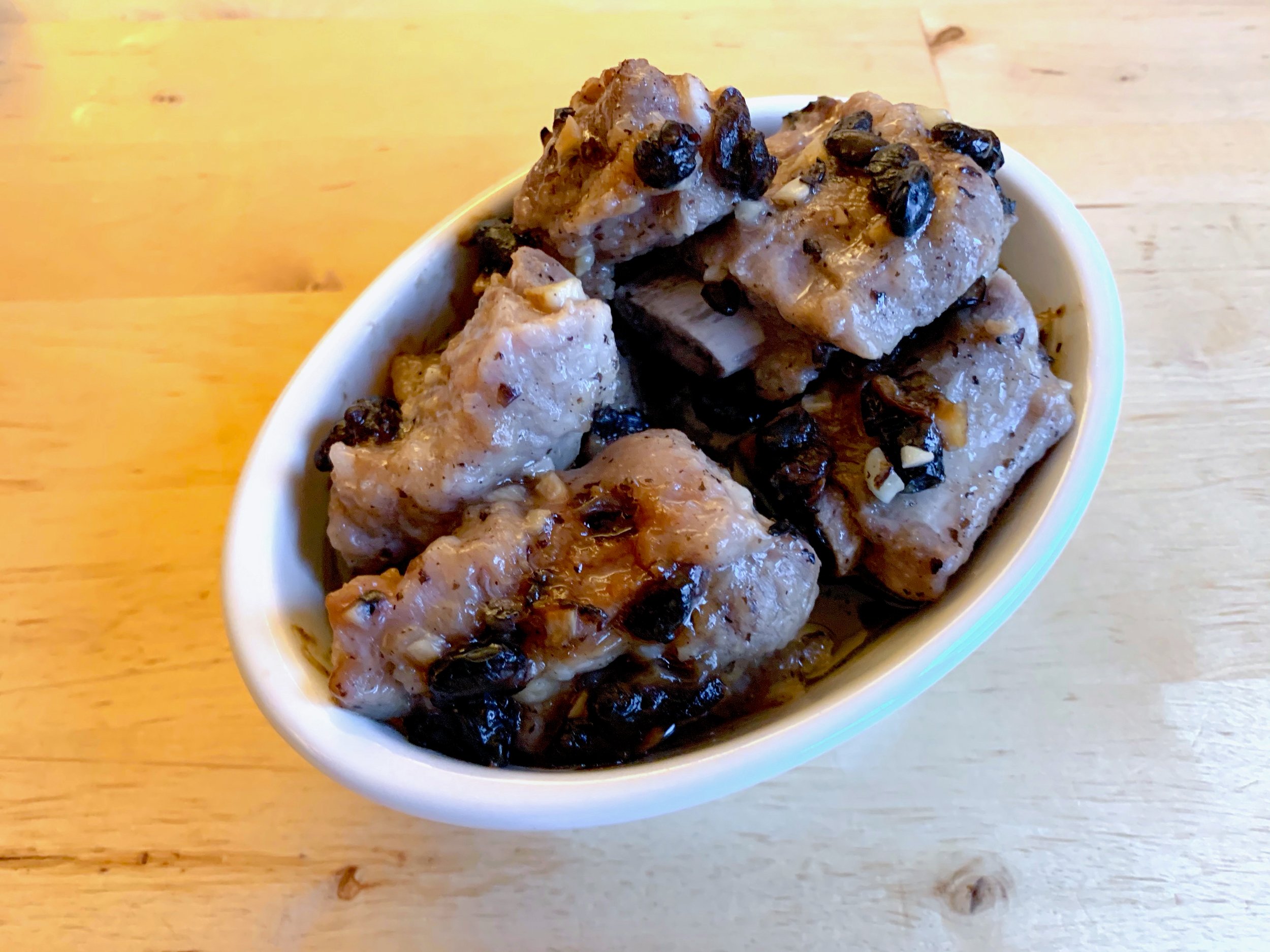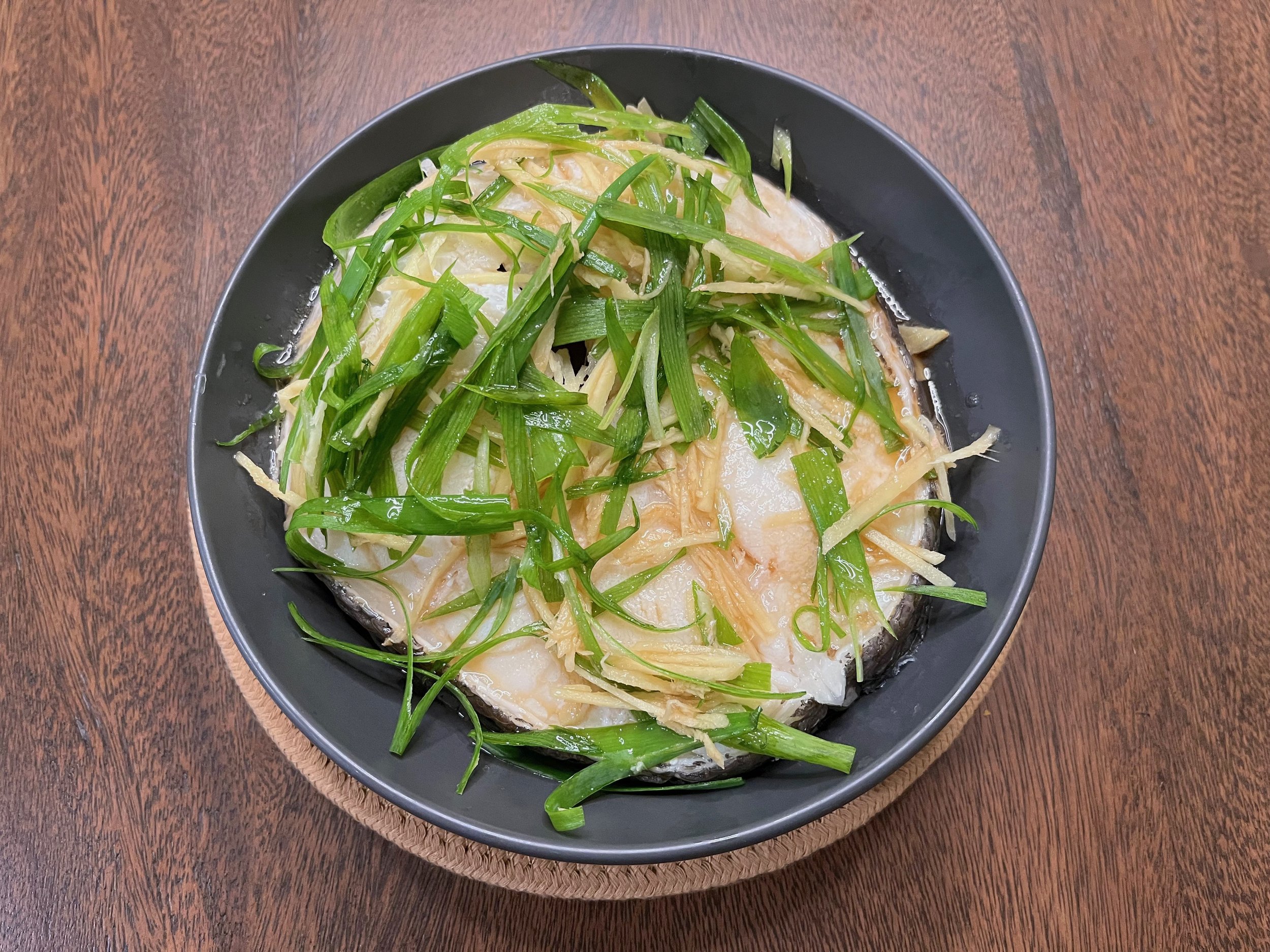Steamed Fish with Black Bean Sauce

清蒸豆豉魚 (Qing Zhen Douchi Yu)
Whole fish is a staple of Chinese lunar new year dinners. Like most other celebratory dishes in Chinese culture, fish owes its place on the banquet table to a bit of wordplay. A common New Year’s blessing is 年年有余, wishing one to have a surplus in the coming year, and the Chinese word for fish, 魚 (yu), is a homophone for 余 (yu), the word for “surplus.” Thus it is considered good luck for the coming year to eat fish.[1] This steamed fish, topped with fermented soybeans, ginger, and scallion, is a simple traditional preparation.
Ingredients
1-2 lb whole white fish (snapper, sea bass, etc.), cleaned and scaled
2 tbsp fermented black beans
2 in ginger
4 scallions
1 tsp soy sauce
1 tbsp vegetable oil
Salt to taste
Fish is generally a delicate and lean protein, which responds well to steaming. You can use any small, mild, white-fleshed fish for this dish. We will look for a fish in the 1 to 2 pound range, which is small enough to handle easily in the home kitchen. Snapper, carp, and sea bass are common choices in Chinese restaurants, but this recipe also works with fish such as trout, tilapia, or branzino. The type of fish is less important than its freshness—in a lightly flavored steamed dish, there isn’t anywhere to hide. Look for a fish with clear eyes and no smell, and cook this dish within a day of buying the fish. The fish should be cleaned and scaled.
The other star of this dish is Chinese fermented black beans, or douchi (豆豉), which can be found in most Chinese grocery stores.[2] These beans aren’t the same as the black turtle beans known in the West (Phaseolus vulgaris). Instead, these are soybeans which have been salted and fermented. This fermentation process is what turns the beans black. These fermented beans are intensely salty and fragrant, similar to a strong miso.[3] Before use, they have to be rinsed, to rinse off some of the salt and partially hydrate the beans. This dish calls for 2 tablespoons of fermented black beans, which must first be rinsed and then gently patted dry.
Rinse the both the inside and outside of the fish with cold water, looking for anything the fishmonger might have missed, such as scales or residual blood in the belly cavity. Pat the fish dry and score the sides of the fish, making long cuts from the skin down to the ribs. Sprinkle the fish with salt, both on the skin and inside the cavity.
Next we will address the aromatics—the ginger and the scallions. As some of these aromatics will be served raw, use a clean cutting board and knife for this! Cut 2 or 3 slices of ginger, and place these slices inside the belly cavity of the fish. These slices will perfume the flesh of the fish while it steams. Finely julienne the remaining ginger, producing narrow matchsticks. Cut the scallions roughly in half, separating the scallion whites from the scallion greens. Set the greens aside for later, and trim the roots from the scallion whites.
This dish will naturally require a steamer basket large enough to fit your whole fish. Fill your steamer with water and bring it to a boil. While the steamer comes up to temperature, we prepare the dish itself.
On a heat-safe plate which can fit into your steamer, lay the 4 scallion whites down. These scallions will keep the fish from direct contact with the plate, helping the fish cook more uniformly. The scallions will also contribute some flavor to the fish. On the exposed side of the fish, we will pack half of the julienned ginger, together with all of the fermented black beans. Place the fish into the steamer basket, and steam until the fish is cooked through—the flesh should flake easily and the juices should run clear. This will take about 10-15 minutes in the steamer, depending on the size of your fish.
While the fish steams, julienne the scallion greens and set aside, together with the remaining julienned ginger. When the cooked fish comes out of the steamer, drizzle over 1 teaspoon of soy sauce, and then pile over the fish the reserved scallions and ginger.
The final touch for this dish is a drizzle of hot oil. This is a common technique in Chinese cooking, helping to bring out the volatile flavors of aromatics without cooking them. In a small saucepan, heat about 1 tablespoon of a neutral vegetable oil such as canola or peanut. When the oil is shimmering and hot, remove it from the heat. Carefully drizzle the hot oil over the fish, and you will be immediately rewarded with the fragrance of scallion and ginger. Serve immediately.
Substitutions
Some varieties of this dish add other aromatics, such as garlic or chili. If you’d like to use them, dice them and add them to the pile of scallions after the fish is steamed. For a nuttier flavor, you can use a sesame oil for the final drizzling step rather than a neutral vegetable oil.
If you are averse to cooking a whole fish, this recipe can be adapted to a cut or fillet from a larger fish, such as cod or halibut.
[1] There are other nuggets of New Year’s symbolism associated with a whole fish. Cooking a whole fish (as opposed to a cut of fish) represents the harmony of a whole (extended) family. Eating the middle of the fish, leaving just the head and the tail, is meant to be a reminder to finish everything one starts. When it comes to flipping the fish to eat the second side, are two distinct traditions. Some families will eat only one side of the fish on New Year’s Eve, saving the second side for New Year’s Day. Other families will flip the fish, but only allow the children to eat the second side. Both traditions speak to the same metaphor—to extend the surplus enjoyed now into the future, be it the coming year or the next generation.
[2] Douchi are the oldest known food to be made from soybeans. A jug of the fermented black beans was found in the tomb of an ancient Chinese noblewoman, dated to 165 BCE.
[3] This similarity is not surprising, as miso is also a fermented soybean product.
Recipe
Prep Time: 10 min Cook Time: 15 min Total Time: 25 min
Difficulty: 2/5
Heat Sources: 2 burners
Equipment: steamer, saucepan
Servings: 4
Ingredients
1-2 lb whole white fish (snapper, sea bass, etc.), cleaned and scaled
2 tbsp fermented black beans
2 in ginger
4 scallions
1 tsp soy sauce
1 tbsp vegetable oil
Salt to taste
Instructions
1. Rinse the fermented black beans with cold water, and pat dry.
2. Rinse the inside and outside of the fish, and pat dry. Score the sides of the fish, and sprinkle the fish with salt, both inside and outside.
3. Cut 2 to 3 slices of ginger, and julienne the rest of the ginger. Remove the scallion tops and reserve them. Trim the roots from the scallions, so we are left with the whole scallion whites.
4. Lay the scallion whites on a plate capable of fitting in your steamer, and place the fish on top of the scallions. Place the ginger slices inside the cavity of the fish.
5. Pack half of the julienned ginger and all of the rinsed fermented black beans on top of the fish.
6. Place the fish into the steamer, and steam until the fish is cooked through, about 10-15 minutes depending on the size of the fish.
7. Meanwhile, julienne the scallion greens.
8. Carefully remove the plate from the steamer, drizzle the soy sauce over the fish, and pile the julienned scallion greens and remaining julienned ginger over the fish.
9. In a saucepan, heat 1 tbsp vegetable oil until shimmering and hot. Drizzle the hot oil over the scallions and serve immediately.














